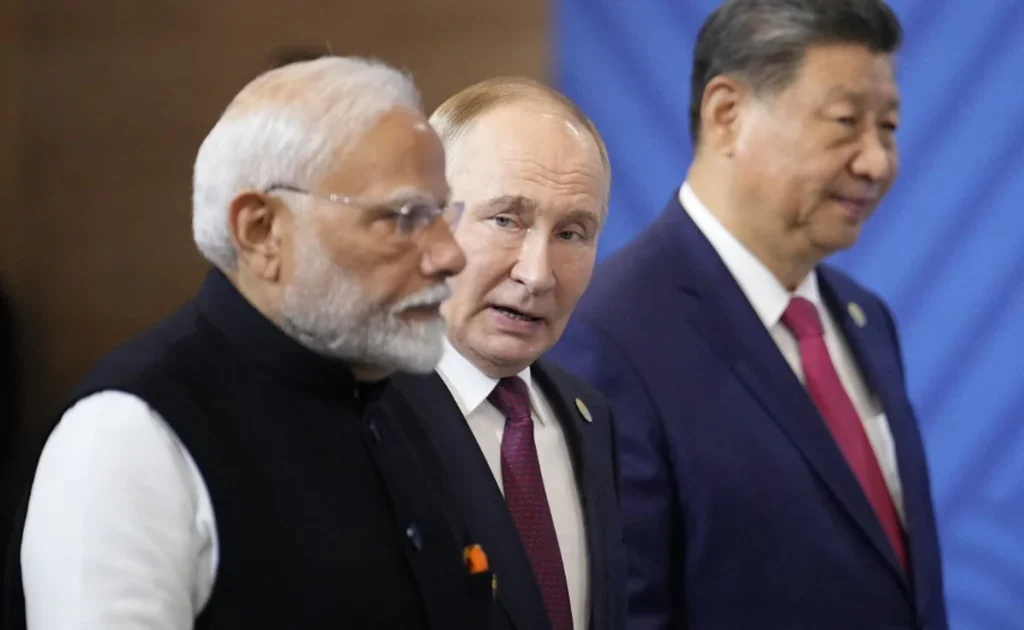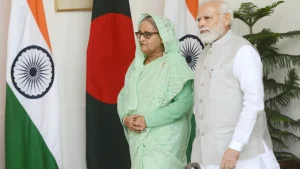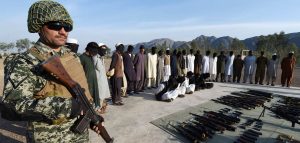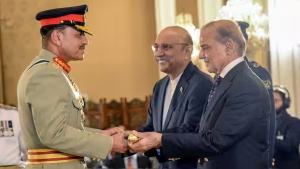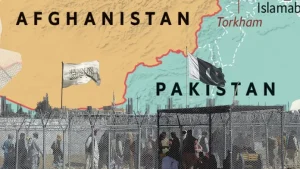The 25th Council of Heads of State of the Shanghai Cooperation Organization (SCO), held in Tianjin on 31 August–1 September 2025, represented more than just another summit of the Eurasian forum. It was staged at a time of cascading global disruptions: the return of protectionist trade wars between the United States and China under Donald Trump’s second presidency; the grinding continuation of the Russia–Ukraine war, with its destabilising effects; instability in the Middle East resulting from the continuing Israeli Genocide in Gaza and the Israel-Iran conflict; and the growing refusal of the Global South to accept Western sanctions and financial dominance.
These structural shifts gave Tianjin the quality of a geopolitical milestone. The SCO was not simply holding its largest summit ever – with ten members, seventeen partners, and several international organisations present – but also positioning itself as the institutional vehicle of multipolarity.
For China, the host and chair, Tianjin offered a chance to display resilience and leadership amid Western pressure. For Russia, still under sanctions and facing diplomatic isolation in Europe, the SCO reinforced Eurasian relevance and economic escape routes. For India, the summit was an opportunity to signal strategic autonomy, avoiding entrapment in a Western-versus-non-Western binary amid growing strains in ties with the Trump administration. For the Global South, Tianjin presented a platform where their voices were amplified rather than subordinated. Against this backdrop, the summit’s optics – its final product, the Tianjin Declaration – gain their significance.
More broadly, the erosion of U.S. unipolarity has encouraged Global South actors to experiment with parallel forums. The SCO, together with BRICS which is a geopolitical and economic bloc of emerging market countries, originally named for Brazil, Russia, India, China, and South Africa, now represents a vast demographic, economic, and territorial footprint – over 40% of the world’s population and a rising share of global GDP. In this environment, Tianjin was not a mere regional gathering but an assertion that Eurasia can act as a counterweight to Western-led architectures such as the North Atlantic Treaty Organization (NATO) and the Group of Seven (G7).
The Optics of Tianjin
Optics were carefully choreographed. High-profile visuals of Chinese President Xi Jinping and Indian Prime Minister Narendra Modi smiling and shaking hands sent signals of pragmatic coexistence, even if not genuine reconciliation, after years of border confrontation.
Moreover, the sheer grandeur of the ceremonies, complete with cultural showcases in Tianjin, reinforced China’s soft power narrative around the “Shanghai Spirit” of mutual trust and cooperation. Meanwhile, the participation of leaders from Iran, Pakistan, Belarus, and Central Asia underscored SCO’s inclusivity as an alternative to Western forums like the G7 or NATO.
Crucially, the SCO avoided openly confrontational rhetoric against the West. Instead, statements emphasized “win-win cooperation,” “indivisible security,” and “mutual respect,” a framing that allowed the grouping to consolidate without declaring itself an anti-Western bloc. The optics were as much about projecting confidence to the West as they were about reassuring domestic and regional audiences of Eurasia’s growing centrality.
The Substance of the Summit
Beneath the optics, Tianjin delivered an unprecedented volume of institutional commitments. The SCO Development Strategy 2026–2035 was adopted, giving the organisation a ten-year framework for deepening cooperation in security, economics, culture, and sustainable development. This was linked to a series of tangible mechanisms, including a Development Bank to provide financial backbone, a Universal Centre for Countering Security Threats, a new Anti-Drug Centre, and proposals for a Centre for Strategic Security Studies.
The economic track was equally ambitious. Member states agreed to accelerate the use of national currencies in settlements, which is a cautious yet deliberate step towards de-risking from the U.S. dollar. The Development Bank, once capitalised, is intended to support infrastructure, digitalisation, energy transition, and industrial modernisation. The SCO also adopted statements on the multilateral trading system, green industry, and sustainable energy development, signalling that it seeks to shape not only security but also economic governance.
On the security front, Tianjin was remarkable for its explicit condemnation of recent terror attacks in Pahalgam (Indian Occupied Kashmir), Khuzdar (Balochistan), and on the Jaffer Express (Balochistan). By naming incidents in both Indian Occupied Kashmir and Pakistan, the SCO managed to bridge a long-standing gap in consensus, one that had previously derailed joint declarations. This was accompanied by commitments to counterterrorism programmes through to 2030 and the initiation of discussions on a defence confidence-building agreement. Such measures elevate SCO security cooperation from rhetorical alignment to embryonic collective mechanisms.
The humanitarian and civilizational track was equally visible. Education, science, culture, sports, and women’s rights were given institutional form, including support for a Dialogue between Civilizations, cultural festivals, and cooperation on artificial intelligence capacity building. The civilizational narrative allowed the SCO to present itself as more than a hard-power bloc, as it framed Eurasia as a cradle of cultural diversity and cooperation.
The Tianjin Declaration as Codification
The Tianjin Declaration, issued on 1 September 2025, encapsulated the summit’s ambitions. Its preamble framed the world as undergoing “profound historical changes” and explicitly called for a more representative multipolar order. It tied the SCO’s mission to the legacy of the United Nations (UN), commemorating the 80th anniversaries of both the end of World War II and the UN’s founding, and insisted on the need for UN reform to include stronger representation of developing countries.
The declaration unfolded across five substantive domains. First, it laid down principles of international order – adherence to the UN Charter, rejection of bloc confrontation, affirmation of sovereignty, and opposition to double standards in human rights. The SCO was cast not as a rival to the UN but as a force to restore its functioning. Second, it institutionalised security cooperation by creating new centres, condemning terrorism with specificity, addressing border management, and highlighting nuclear safety. Notably, it condemned U.S. and Israeli strikes on Iran as violations of international law, embedding anti-interventionist language into SCO consensus. Third, it charted an economic agenda: support for multilateral trade, opposition to unilateral sanctions, promotion of energy security, and the establishment of a Development Bank. Fourth, it advanced humanitarian and cultural cooperation, with commitments in education, AI, public health, tourism, sports, and climate. Finally, it refined SCO’s institutional framework by merging observer and dialogue categories into a single “SCO partner” status, consolidating its external engagement model.
How to Read Tianjin
The Tianjin Declaration is not a revolutionary charter, but it is more than diplomatic boilerplate. Its importance lies in its operationalisation. Terrorism, trade, finance, and energy are not simply discussed but paired with concrete centres, banks, roadmaps, and programmes. The SCO clearly appears to be transitioning from a declaratory forum to a functional organisation with its own financial instruments, specialised agencies, and long-term strategies.
At the same time, Tianjin underscored the SCO’s self-image as a complement, not a replacement, to the UN. Putin and Xi had in their speeches previously stressed that the SCO is formalising a multipolar world that is already emerging, not engineering an alternative world order. The framing is designed to reduce the risk of confrontation with the West while quietly building the infrastructure of autonomy.
The risks remain evident. The SCO’s unity is fragile, as India–China border disputes and Pakistan–India tensions could easily undermine momentum. Implementation will depend on whether the Development Bank is capitalised, whether national-currency settlements scale up, and whether security centres gain operational autonomy. Yet Tianjin demonstrated that SCO leaders are willing to translate the rhetoric of multipolarity into institutions.
Policy Implications of the Tianjin Declaration
The Tianjin Declaration represents the SCO’s most ambitious institutional agenda to date. While it does not herald a new world order, it codifies a steady evolution toward multipolar governance with practical mechanisms – financial, security, and cultural – that can reshape the geopolitical landscape over time.
For Western policymakers, the declaration is best read as an evolution rather than a revolution. It signals institutional consolidation in Eurasia, not the abrupt emergence of a rival bloc. Yet dismissing it as empty rhetoric would be strategically costly. The SCO is embedding itself as a serious platform for finance, security cooperation, and narrative-building. Overreaction, however, could be equally damaging. Heavy-handed attempts to isolate SCO members risk driving “fence-sitters” like India, which continues to hedge between the West and Eurasia, more firmly into the SCO’s orbit. The challenge for Western capitals, therefore, is to calibrate by neither ignoring SCO’s growing relevance, nor provoking unnecessary polarization.
For the Global South, the Tianjin Declaration illustrated that the SCO is no longer just a Eurasian security club. With its new Development Bank, counterterrorism and anti-drug centres, and a civilizational dialogue platform, the SCO is building instruments that offer states opportunities for cooperation beyond Western-dominated institutions. These platforms provide leverage – alternative financing, security coordination, and soft power venues – that can be used to negotiate with both the West and within multilateral settings.
For advocates of multilateral reform, the Declaration’s emphasis on strengthening the UN and its governing bodies, particularly the Security Council, is significant. The SCO is not rejecting the UN framework but attempting to reshape it from within, aligning with long-standing Global South demands for representation. This insistence injects momentum into reform debates that have often stalled and positioned the SCO as both a constituency and a pressure group in future negotiations on global governance.
The Tianjin Declaration does not mark a rupture in the international system, but it accelerates a rebalancing process that Western capitals, Global South states, and reform advocates must interpret carefully. It is an institutional consolidation of multipolarity – patient, deliberate, and increasingly tangible.
Annex: Mapping the Tianjin Declaration
| Domain | Key Commitments | Concrete Mechanisms/Outcomes |
| Principles & Multilateralism | Commitment to UN Charter; rejection of bloc politics; call for UN reform and stronger role of the Global South; adoption of SCO Development Strategy 2035. | Proposal for Eurasian Charter on Diversity & Multipolarity; support for UN resolution on “Decade for Peace for Future Generations.” |
| Security | Condemnation of terrorism “without double standards”; explicit mention of attacks in Pahalgam, Khuzdar, and Jaffer Express; opposition to U.S.–Israeli strikes on Iran; support for Palestinian statehood; concern over nuclear safety. | Establishment of Universal Centre for Countering Security Threats; Anti-Drug Centre in Dushanbe; Programme on Countering Extremist Ideology (2026–2030); proposal for agreement on military confidence-building; cooperation with UN counterterrorism frameworks. |
| Economy & Connectivity | Promotion of multilateral trade; opposition to unilateral sanctions; protection of supply-chain stability; commitment to energy cooperation and sustainable transition. | Establishment of SCO Development Bank; Roadmap for Energy Cooperation to 2030; support for China–Kyrgyzstan–Uzbekistan railway; digital customs and trade facilitation mechanisms; Programme for SCO e-commerce cooperation. |
| Humanitarian & Civilizational Cooperation | Commitment to education, AI, governance, cultural heritage, tourism, sports, health, women’s and youth empowerment. | Global Dialogue of Civilizations platform; SCO University initiatives; AI Roadmap (2025, Chengdu); Regional AI Centre in Dushanbe; proposal for SCO Medical Association; SCO Sports Association and Winter Sports Zone; SCO Year of Sustainable Development follow-up. |
| Institutional Evolution | Consolidation of membership categories; reaffirmation of Central Asia as SCO’s core. | Merger of observer and dialogue partner into new “SCO Partner” status; Laos granted partner status; chairmanship transferred to Kyrgyzstan for 2026 under the theme “25 Years of SCO.” |




